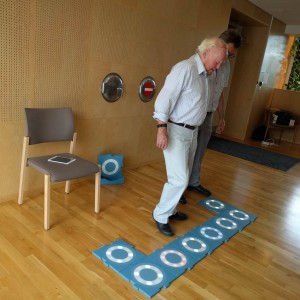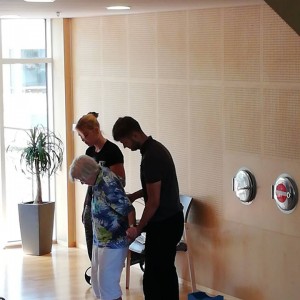REACH Early testing period completed
Early testing (test period 1: M1 – M24) up to date covered a series of explorative, qualitative tests conducted around or with the 4 use case settings HUG, ZZ, Lyngby, SK. It covered qualitative testing of early mock-ups of sensors/equipment to develop requirements regarding acceptability, usability, early detection and intervention regimes.
Early testing so far covered following activities:
- Lyngby I: Early study (RCT, crossover design; duration: 5 weeks; Nov. + Dec. 2016) with 22 elderlies living at home to detect weather and to what extent feedback has an impact on physical activity. The test covered mainly the M and I testing instances and provided cross sectional inputs for all PAD areas. à Outcomes reported in Deliverable T1.4/D4
- Lyngby II: Early study (feasibility study; duration: 8 weeks; Summer 2017) with 10 elderlies living at home to detect if basic features of a physical engagement environment in Touchpoint 4 – such as the Playware Tiles – lead to improvement of the functional ability. The test covered mainly the M and I testing instances and provided for PAD area 4 (gaming and training). à Outcomes reported in Deliverable T7.1/D29.


- SK I: explorative (comparative study – wearble sensors vs. Fitbit and ActivePAL sensors – with healthy subjects; duration: 2 weeks; Summer 2017) test with 7 test subjects with SC’s medical grade wearable sensors to explore its application areas in PAD area 2 (micro mobility, postures, ADLs, etc.; Touchpoint 2) à Outcomes will be reported in Deliverable T2.3/D6
- HUG I: usability test of early mock-up of Touchpoint 1 (usability test under controlled conditions at HUG with 15 elderlies, duration: several hours; test conducted in spring 2017). The test involved AMs mobility device, a gaming approach and wearable sensors. The test served PAD category 1 (mobility, Touchpoint 1) and crossed several SMI testing instances. à Outcomes reported in Gerontechnology Journal Issue 3/2017(October 2017) and used in Deliverable T4.3/D15
- Alreh I: usability test of early mock-up of Touchpoint 1 (usability test under controlled conditions at AM with 14 elderlies, duration: several hours; test conducted in summer 2017). The test involved AMs mobility device and a gaming approach. The test served PAD category 1 (mobility, Touchpoint 1) and crossed several SMI testing instances. à Outcomes reported in Gerontechnology Journal Issue 3/2017(October 2017) and used in Deliverable 3/D15
- ZZ I: Explorative test related to behavior change and motivational techniques (qualitative test with 52 Senior Citizen clients of ZZ who already attend ZZ activities one or more days a week, duration: 10 weeks; test conducted Feb. – April 2017). The test goal was to identify what motivates senior clients of Zuid Zorg (ZZ) to move/ be physically active. Test served PAD 3 (socializing and nutrition, Touchpoint 3) and focused mainly on the M testing instance. à Outcomes reported in Gerontechnology Journal Issue 3/2017(October 2017) and Deliverable T7.1/D29
- EPFL I: Ethnographic study (qualitative study with 20 participants: 13 females, 7 males; Age: between 65 and 89, with a mean age of 77 Serious health conditions limiting them in doing physical activities; test involved a pre-study, intermediate debriefing, and post-study structured interview; duration: 6 weeks). Goal of the study was to obtain insights on elderly’s attitudes towards increasing physical activity as well as their readiness towards tracking technologies identify senior’s potential behavior changes as well as their usage intention, shed light on the opportunities and barriers for them to be monitored, and understand how they would integrate the system in their daily life and what type of data can be collected. Test served in a cross-sectional manner to all SMI and PAD categories. à Outcomes reported in Gerontechnology Journal Issue 3/2017(October 2017) and will be discussed in more detail in Deliverable T3.1-3/D9
Its outcomes of test period 1/ early testing in reporting period 1 were used to a large extent to detail the REACH’s unique Sensing-Monitoring-Intervention activity flow and the major REACH Touchpoints and the early warning and detection dimensions of REACH.


Leave a reply
Du musst angemeldet sein, um einen Kommentar abzugeben.